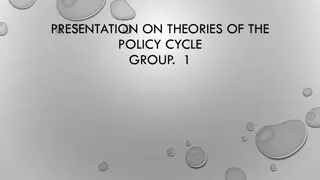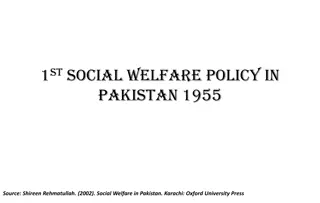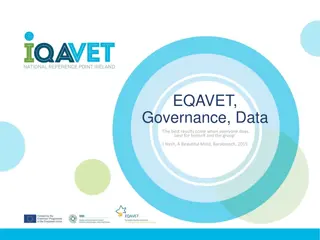EU Social Policy and Governance
This presentation delves into the European Union's social policy framework and its multi-level governance structure. Discussing the EU's role in social policy, it explores competences, subsidiarity, and the monitoring of social situations. The institutional setup, including the European Commission, Council of the EU, European Parliament, and Court of Justice, is examined in detail. Legal provisions, primary and secondary legislation, and the doctrines of direct effect and supremacy are highlighted, showcasing the complexity of the EU's governance system in social matters.
Download Presentation

Please find below an Image/Link to download the presentation.
The content on the website is provided AS IS for your information and personal use only. It may not be sold, licensed, or shared on other websites without obtaining consent from the author.If you encounter any issues during the download, it is possible that the publisher has removed the file from their server.
You are allowed to download the files provided on this website for personal or commercial use, subject to the condition that they are used lawfully. All files are the property of their respective owners.
The content on the website is provided AS IS for your information and personal use only. It may not be sold, licensed, or shared on other websites without obtaining consent from the author.
E N D
Presentation Transcript
Social Policy in the EU and the Role of the EU Tim Goedem tim.goedeme@kuleuven.be tim.goedeme@uantwerpen.be Lecture 3 24/02/2016 & 02/03/2016
This lecture: Introduction to the EU and Social Policy The EU as a system of multilevel governance Social aims, but few competences? Subsidiarity Governing social policy in the EU How to make sense of limited role for EU in field of social policy? The monitoring of the social situation & social policy in the EU (Rudi Van Dam)
The EU: a system of multi-level governance Similar to federal state Political authority is shared between territorial units and central government Division of labour between central government and other units in decision-making Constitutional court settles legal disputes concerning the division of power Unlike a federal state: No financial resources More complex layers A system of multilevel governance
The EU: a system of multi-level governance Institutional structure European Commission DG for Employment, Social Affairs and Inclusion DG for Health and Consumers Council of the EU (Council of Ministers, the Council) (<-> Council of Europe!) Employment, Social Policy, Health and Consumer Affairs Council European Council (2 summits a year in Brussels) European Parliament Directly elected since 1979 Co-decision, cooperation and consultation Court of Justice of the EU (JCEU) (incl. Court of First Instance, 1986)
The EU: a system of multilevel governance- Three sources of binding legal provisions: Primary legislation: Treaties secondary legislation: Directives and regulations + CJEU rulings Doctrines developed by CJEU in early 1960s: Direct effect: EU law is directly enforceable in national courts Supremacy: supremacy of EU law over national law
Source: Anderson, 2015: 53
Social aims, but weak competences? Treaty of Lisbon amended two basic treaties of EU Now: Treaty on European Union (TEU) (amendment of Maastricht Treaty) Treaty on the Functioning of the European Union (TFEU) (amendment of Treaty of Rome)
Social aims, but weak competences? Clear, and important social aims in Treaties Some examples from TEU:
Social aims, but weak competences? Clear, and important social aims in Treaties Some examples from TEU:
Social aims, but weak competences? And the horizontal social clause in the TFEU:
Social aims, but weak competences? And Title X of TFEU is entirely dedicated to social policy The Union shall support and complement the activities of MS in, for instance, the following fields (Article 153 TFEU): Working conditions & Workers health and safety Social security and social protection of workers Protection of workers where contract has ended Integration of persons excluded from the labour market Equality between men and women Combating of social exclusion Modernisation of social protection systems And there are separate provisions for a European Social Fund, as well as social services (new in Lisbon Treaty)
Social aims, but weak competences? Treaty of Lisbon also made the Charter of Fundamental Rights of the EU legally binding Especially Title IV relevant for social policy, e.g.:
Social aims, but weak competences? At the same time, competences in the social field are limited No social topic as exclusive competence of the EU (art. 3 TFEU) Article 4 TFEU indicates a shared competence with MS for economic, social and territorial cohesion; and social policy for the aspects defined in this Treaty .
Social aims, but weak competences? TFEU, article 5:
Social aims, but weak competences? Article 6 TFEU states that The Union shall have competence to carry out actions to support, coordinate or supplement the actions of the Member States. (a) protection and improvement of human health; (e) education, vocational training, youth and sport
Social aims, but weak competences? While in the field of social policy, the facilitating role of the European Commission is stressed (Article 156 TFEU): the Commission shall encourage cooperation between the Member States and facilitate the coordination of their action in all social policy fields employment, labour law and working conditions, basic and advanced vocational training, social security, prevention of occupational accidents and diseases, occupational hygiene, the right of association and collective bargaining between employers and workers.
Social aims, but weak competences? And also, the purview of horizontal clause (Article 9 TFEU) is limited (Dawson and de Witte, 2012): Is not accompanied with competences to act in the fields mentioned Cannot be used as a legal base for a pro-active and comprehensive EU social policy
Social aims, but weak competences? But (Dawson and de Witte, 2012): mainstreams social concerns into all EU policy fields Affirms that social objectives are on equal footing with economic objectives within EU primary law It requires all EU actors to find a proper balance between economic, social and other aims (e.g. in case of competition law, the internal market law, and external trade law) => question of achieving a proper balance becomes subject of discussion within EU institutions, including Council, CJEU, ) => aims listed in social clause should become part and parcel of the objectives of internal market and competition policies? => shall social concerns play a greater role than they have done so far in EU policies?
Social aims, but weak competences? While finally, as elsewhere, explicitly stressing principle of subsidiarity in the Charter of Fundamental Rights (cf. below):
Subsidiarity Especially in the area of social policy, the principle of subsidiarity is often called upon Principle of subsidiarity is closely linked to principle of conferral and principle of proportionality
Subsidiarity Treaty of Lisbon Article 5, Protocol on the application of the principles of subsidiarity and proportionality: Draft legislative acts shall be justified with regard to the principles of subsidiarity and proportionality. Any draft legislative act should contain a detailed statement making it possible to appraise compliance with the principles of subsidiarity and proportionality. This statement should contain some assessment of the proposal's financial impact and, in the case of a directive, of its implications for the rules to be put in place by Member States, including, where necessary, the regional legislation. The reasons for concluding that a Union objective can be better achieved at Union level shall be substantiated by qualitative and, wherever possible, quantitative indicators. Draft legislative acts shall take account of the need for any burden, whether financial or administrative, falling upon the Union, national governments, regional or local authorities, economic operators and citizens, to be minimised and commensurate with the objective to be achieved.
Subsidiarity & proportionality 3 criteria aimed at establishing the desirability of intervention at EU level (EUR-Lex): Does the action have transnational aspects that cannot be resolved by EU countries? Would national action or an absence of action be contrary to the requirements of the Treaty? Does action at EU level have clear advantages?
Subsidiarity & proportionality The EU can only act in a policy area if (EUR-Lex): the action forms part of the competences conferred upon the EU by the Treaties (principle of conferral); in the context of competences shared with EU countries, the EU level is most relevant in order to meet the objectives set by the Treaties (principle of subsidiarity); the content and form of the action does not exceed what is necessary to achieve the objectives set by the Treaties (principle of proportionality).
Subsidiarity Not only legal principle, but also (Vandenbroucke et al., 2013): Traditional political cleavage between: subsidiarists (prefer to minimize direct interventions by the EU, esp. soc protection) federalists (who may, at least in principle, be open to more direct EU intervention in the social domain) Logic of subsidiarity at the national level, especially with regard to minimum income protection => subsidiarity and proportionality put strong constraints on EU action in the social domain
Governing social policy in the EU Anderson (2015:31): the development of social policy in the EU is a story of regulatory politics mainly in the service of negative integration Small budget (+/- 1% EU GDP) => regulation regulatory <-> fiscal policies EU is in business of market-making rather than redistributive policies for polity building Setting rules and standards for governing liberalisation, with interactions with & impact upon social policies Negative integration vs. positive integration
Governing social policy in the EU Positive integration = EU initiatives aimed at establishing common standards or policies Negative integration = removing barriers to economic activity in order to create a common market Four freedoms: Capital Goods Services Labour
Governing social policy in the EU In social field, focus mainly on negative integration (esp. for realising free movement of labour) Nature of treaties: commitment to common market, with EC & CJEU as main actors Limits to positive integration: extension of qualified majority voting (QMV) & co-decision; <-> social security subject to unanimity Remember diversity between EU MS welfare states and social policies
Governing social policy in the EU In many fields, the focus is on second-order outcome governance? (Armstrong, 2010; Vandenbroucke et al., 2013) First-order governance: the EU substitutes its own governance structures and processes for national governance structures and processes Second-order governance: the EU does not substitute its own structures and processes of governing for another but rather seeks externally to influence an already constituted system of governance => the governance of governance Input governance: concerns policies (e.g. minimum standards for occupational health and safety) Outcome governance: concerns social outcomes (e.g. employment target, poverty reduction target) First-order Second-order Input A B Outcome C D
Governing social policy in the EU Moving from input to outcome governance and first to second- order way to overcome diversity and subsidiarity? Hard law Requirements and principles set out in treaties Soft law Non-binding policy instruments Compromise between doing nothing and undesirable binding provisions? Example: Open method of coordination and monitoring of EU2020 poverty reduction target and social policies in European Semester
How to make sense of limited role for EU in social policy? Two questions central in Anderson s (2015) analysis: Why is it difficult for Member States (MS) to agree on transferring considerable competences in social field to EU? How can we understand the expansion of the EU s social policy competences despite a weak Treaty basis MS reluctance to transfer social policy competences?
How to make sense of limited role for EU in social policy? Two questions central in Anderson s (2015) analysis: Why is it difficult for Member States (MS) to agree on transferring considerable competences in social field to EU? How can we understand the expansion of the EU s social policy competences despite a weak Treaty basis MS reluctance to transfer social policy competences?
How to make sense of limited role for EU in social policy? Assumption about upward convergence as a corollary of the common market at the start Status quo bias of EU institutions in field of social policy (unanimity requirement in many areas, subsidiarity) Diversity in social policy in MS (and result of democratic decision-making) Diversity in social situation in MS precludes one-size-fits-all policies? (but outcome governance ) Social policy is different from other European policies Social programmes large share of public budgets & affect everyone High political salience in national politics Social policy provides much of the legitimation for modern democratic governments (social policy and state-building)
Some points to remember Social objectives have prominent place in Treaties Horizontal clause should / could put social objectives on equal footing with other objectives But, except for health and training, competences in social domain very limited, allowing mainly for soft law Subsidiarity is important principle Several factors have contributed to the limited role of the EU in social policy
references Anderson, K. M. (2015), Social policy in the European Union, London: Palgrave, 252p. Dawson, M., and de Witte, B. (2012), 'The EU legal framework of social inclusion and social protection: Between the Lisbon Strategy and the Lisbon Treaty', in Cantillon, B., Verschueren, H. and Ploscar, P. (eds.), Social inclusion and social protection in the EU: Interactions between law and policy, Cambridge: Intersentia, pp. 41-69. Pollack, M. A. (2015), 'Theorizing EU policy-making', in Wallace, H., Pollack, M. A. and Young, A. R. (eds.), Policy-Making in the European Union. Seventh Edition, Oxford: Oxford University Press, pp. 12-45. Vandenbroucke, F., Cantillon, B., Van Mechelen, N., Goedem , T., and Van lancker, A. (2013), 'The EU and Minimum Income Protection: Clarifying the Policy Conundrum', in Marx, I. and Nelson, K. (eds.), Minimum Income Protection in Flux, Hampshire: Palgrave Macmillan, pp. 271-317. Wallace, H., and Reh, C. (2015), 'An institutional anatomy and five policy modes', in Wallace, H., Pollack, M. A. and Young, A. R. (eds.), Policy-Making in the European Union. Seventh Edition, Oxford: Oxford University Press, pp. 72-112.























